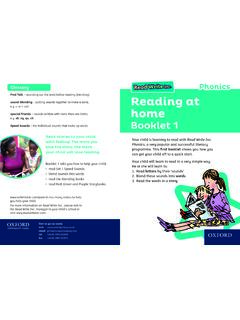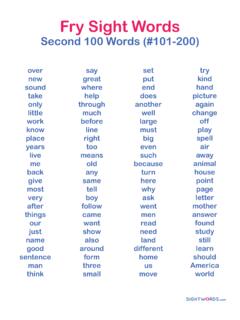Transcription of Making a strong start: a guide for Reception/Primary 1 ...
1 < strong >Makingstrong > a strong start < strong >readstrong > write Inc < strong >phonicsstrong > < strong >Makingstrong > a strong start: a < strong >guidestrong > for < strong >Reception/Primarystrong > 1. teachers Series developed by Ruth Miskin 2. 3. Great Clarendon Street, Oxford, OX2 6DP, United Kingdom Oxford University Press is a department of the University of Oxford. It furthers the University's objective of excellence in research, scholarship, and education by publishing worldwide. Oxford is a registered trade mark of Oxford University Press in the UK and in certain other countries. Oxford University Press 2019. Acknowledgements Illustrations: Aptara; Tim Archbold Photographs: by kind permission of Ruth Miskin Training Links to third party websites are provided by Oxford in good faith and for information only. Oxford disclaims any responsibility for the materials contained in any third party website referenced in this work. Contents Letter from Ruth Introduction to teaching < strong >phonicsstrong > SECTION 1: ORGANISATION IN < strong >Reception/Primarystrong > 1.
2 How to group your children for < strong >phonicsstrong > lessons in < strong >Reception/Primarystrong > 1 6. SECTION 2: STARTING strong IN < strong >Reception/Primarystrong > 1. Route through the first half-term an overview 10. Getting going in week 1 12. SECTION 3: TEACHING < strong >set 1strong > SPEED SOUNDS AND WORD TIME. How to use Handbook 1 and resources 14. Assessing as you go 14. < strong >readstrong > write Inc. < strong >phonicsstrong > through the day: Fred Talk and pinny time 15. Daily handwriting practice 17. How to help parents: practise the sounds 18. SECTION 4: STOPPING CHILDREN STRUGGLING ONE-TO-ONE TUTORING. Part 1: Learning < strong >set 1strong > Speed Sounds single-letter sounds 21. Part 2: Blending sounds into words 23. Part 3: Reading < strong >phonicsstrong > Green Word Cards: Word Time to 24. Part 4: Learning < strong >set 1strong > Speed Sounds Special friends 24. Part 5: Reading < strong >phonicsstrong > Green Word Cards: Word Time and 25. SECTION 5: PHOTOCOPY DITTIES, RED DITTY BOOKS AND STORYBOOKS. How to use < strong >readstrong > write Inc.
3 < strong >phonicsstrong > Handbook 1 and resources 26. How to progress quickly from Ditties to Storybooks 28. SECTION 6: HOME READING. Reading and re-reading < strong >readstrong > write Inc. < strong >phonicsstrong > books 30. SECTION 7: STORYTIME, PLANNED TALK AND TALK THROUGH STORIES. Storytime 31. Planned talk 34. Talk Through Stories 34. Sound Blending Books progression 36. Ditty Photocopy Masters progression 40. < strong >Makingstrong > a strong start Dear < strong >Reception/Primarystrong > 1 teachers, I'm delighted that you've decided to make reading a priority in your school. I hope this < strong >guidestrong > will help you get your children off to a speedy start in < strong >Reception/Primarystrong > 1. We've written it to go alongside < strong >readstrong > write Inc. < strong >phonicsstrong > Handbook 1 to meet the particular demands of a < strong >Reception/Primarystrong > 1. classroom. I'm sure that your Reading Leader will help you use this < strong >guidestrong > to organise your groups and ensure the teaching is the best it can be. The most important starting point is to < strong >readstrong > to children.
4 Reading to children is the best way of encouraging them to love books and reading. By reading stories aloud to children every day, you are forming a link for them between reading, comfort and love. When you love a book, your children will want to hear it again and again! Children thrive on repetition, so when you've < strong >readstrong > Room on the Broom for the hundredth time, remember you are hardwiring their brains for success! Children learn more rapidly at this age than at any other time in their lives so, once you start teaching < strong >phonicsstrong > , you can teach a new sound every day. The important thing to remember is to always review any previously taught sounds, as well as teaching the new sound. The speed at which children < strong >readstrong > the sounds will make the biggest difference to their blending of sounds to < strong >readstrong > words. Do keep the teaching of sounds to the < strong >phonicsstrong > lessons. Please don't use other contexts to practise, for example in the outdoor area or the role-play area.
5 Let children enjoy the integrity of each experience. Remember that children can only be as good as your teaching. After you've been on the < strong >readstrong > write Inc. < strong >phonicsstrong > training, practise with your colleagues until you are confident you can make the lessons fun for both you and your children. I would love to hear about your success. Best wishes 4. < strong >Makingstrong > a strong start Introduction to teaching < strong >phonicsstrong > Some of the most frequent questions I'm asked . What if a child cannot articulate particular sounds? Ask the child to repeat the sounds in the alphabet after you (sounds not letter names). Make a note of the sounds the child has difficulty pronouncing, for example, t instead of c, d instead of g, w instead of r, sch instead of s, f instead of th. You will then know when to accept their pronunciation of the sound; just because the child can't say the sound correctly doesn't mean they can't hear it correctly.
6 With practice, they will soon start to pronounce the sounds correctly. Should we make children learn the sounds? You won't have to make children learn the sounds. You will make these lessons so much fun, they will want to join in. What if a child doesn't want to join in? Let the child watch from the sidelines to begin with. Once they see how much fun the lessons are, they will gradually join in. If they still seem reluctant to join in, you should teach them one-to-one. Should we teach letter names? Teach children the alphabet song, so they will know the letter names when Year 1/. Primary 2 class teachers use letter names for spellings. However, do not use the letter names in < strong >phonicsstrong > lessons. When you show children a letter, you need them to react quickly by saying the associated sound and not the letter name. This will make blending sounds into words much easier.
7 5. 1: Organisation in < strong >Reception/Primarystrong > Reception 1. SECTION 1: ORGANISATION. IN < strong >Reception/Primarystrong > 1. Minimum expectations for your children's progress October: know most single-letter < strong >set 1strong > Sounds and begin to blend ( < strong >set 1strong > Sounds Group B). December: know single-letter < strong >set 1strong > Sounds and be able to blend orally ( < strong >set 1strong > . Sounds Group C). February: reading Photocopy Ditties 1 20*. April: reading Red Ditty Storybooks May: reading Green Storybooks July: reading Green/Purple Storybooks How to group your children for < strong >phonicsstrong > lessons in < strong >Reception/Primarystrong > 1. Children should always be taught in homogeneous groups. Choose the best option from the three below based on the number of staff you can make available. Make the best use of teaching assistants (TAs) from other year groups to support YR/P1 in < strong >readstrong > write Inc. < strong >phonicsstrong > lessons: the sooner YR/P1 learn to < strong >readstrong > , the less work you will need to do later.
8 This guidance is based on one-form entry so can be replicated for as many classes as needed. However, for two-form entry+ schools, consider grouping across classes from autumn half-term. The strongest reading teacher should teach the slowest progress group. Top tips for organisation in YR/P1. If YR/P1 don't attend assembly during the first half-term, utilise as many YR/P1 and Y1/P2 < strong >readstrong > write Inc. < strong >phonicsstrong > trained teachers and TAs as possible by teaching the daily Speed Sounds and Word Time Lessons (20 minutes). during assembly time. Teach YR/P1 at a different time to Y1/P2 so you can use staff and teaching spaces twice. Assess and group children at the start of YR/P1 if children were taught the < strong >set 1strong > . Sounds in nursery. * These can be found in the Ditty Photocopy Masters Handbook. 6. < strong >Makingstrong > 1: Organisation a strongin start < strong >Reception/Primarystrong > 1. Option 1 class teacher and two TAs (best option).
9 Term 1: 20 minutes teaching per group First four weeks Whole class: 5 minutes (teacher and two TAs team-teach at the front). Teach < strong >set 1strong > Speed Sounds. Followed by: Three progress groups: 15 minutes Teach letter formation and Word Time reading at tables. Play Fred Talk games. After four weeks Three simultaneous progress groups: 20 minutes each Teach Speed Sounds Lesson, including letter formation and Word Time reading and spelling at tables. Keep up group: teach in a group of four (see ) and/or daily one-to-one tutoring for 5. minutes. NB Once children begin the Photocopy Ditties, teach a 30-minute session. Term 2: 30 minutes teaching per group Three simultaneous progress groups Teach Speed Sounds Lesson (10 minutes), Ditties/Storybooks (20 minutes). Keep up group: teach in a group of four and/or daily one-to-one tutoring for 5 minutes. Term 3: 40 60 minutes teaching per group Three simultaneous progress groups Teach Speed Sounds Lesson (10 minutes), Ditties/Storybooks (at least 30 minutes).
10 Keep up group: teach in a group of four and daily one-to-one tutoring for 5 minutes if any children are still learning < strong >set 1strong > Sounds and blending. 7. < strong >Makingstrong > 1: Organisation a strongin start < strong >Reception/Primarystrong > 1. Option 2: class teacher and one TA. Term 1: 20 minutes teaching per group First four weeks Whole class: 5 minutes (teacher and TA team-teach at the front). Teach < strong >set 1strong > Speed Sounds. Followed by: Three progress groups: 15 minutes (teacher takes two groups in succession, TA takes one). Teach letter formation and Word Time reading at tables. Play Fred Talk games. Set up an independent play activity for the third group for 15 minutes. After four weeks Three progress groups: 20 minutes each (teacher takes two groups in succession, TA takes one or two if two keep up groups are required). Teach Speed Sounds Lesson including letter formation and Word Time reading and spelling at tables.










